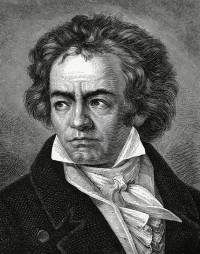Classical Era: Important Composers, Theorists, and Performers: Beethoven
Ludwig van Beethoven (1770-1827, German)

![]() Listen to the example below:
Listen to the example below:
Beethoven is probably one of the world’s best composers of all time. He performed his first concert at 8 years of age, was employed as deputy court organist at 12, studied with Haydn at 23, and began to go deaf at 26. His deafness proved to be his largest challenge. Interestingly, it did not affect his ability to compose. He was more concerned with what the public would think if they knew he was deaf. Toward the end of his career it was obvious, and many stepped up to help him in conducting. He did not want their help and insisted upon doing it himself. So, they would often have an extra conductor stand behind him to keep the orchestra together since he could not hear the musicians. He was unaware of this assistance, and he was also unaware of the audience’s applause until the musicians would turn him around to see it. He never married, but was often in love with women who were unattainable. His paranoia and dramatic reactions were created by his increasing deafness.
Both Beethoven and his music were very impulsive, fiery, and spontaneous. It was from studying with Haydn that he learned how to write symphonies and string quartets, and Haydn’s influence is very evident in Beethoven’s earlier works. As Beethoven started to realize he was losing his hearing, understandably things started to change. Expressing his pain through music, Beethoven took music from the Classical style to the Romantic period simply by introducing feelings.
Some of Beethoven’s most significant works include:
- Heroic Symphony – known as the Eroica Symphony. This is where Beethoven found his own unique voice, composing the symphony on a very grand scale where it ended up being almost twice as long as any symphony coming before it.
- Fifth Symphony – his most famous symphony.
- "Ode to Joy" – coming from his Ninth Symphony. This symphony was the first to involve singers—four soloists and a large chorus.
![]() Listen to the following examples below:
Listen to the following examples below:
Ludwig van Beethoven - Symphony no. 5 in c minor, op. 67 - i. allegro con brio (2 minute 10 second clip)
Attribution: Ludwig van Beethoven [Public domain or Public domain], via Wikimedia Commons This work comes from the non profit U.S. organization Musopen where it is available at the following link: http://www.musopen.com/view.php?type=composer&id=23 This work has been released into the public domain by its author, Skidmore College orchestra. This applies worldwide.
Beethoven: Piano Sonata No 1 – Movement 1, Allegro (2 minute cilp)
Attribution: Ludwig van Beethoven [Public domain], via Wikimedia Commons. Internet Archives. This sound recording is not protected because it was published in the European Union more than 50 (Directive 2006/116/EC) or 70 years ago (Directive 2011/77/EU) and the rights of its performers and producers have expired.
